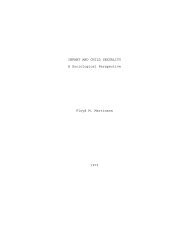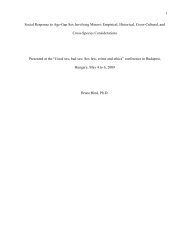Download PDF - Springer
Download PDF - Springer
Download PDF - Springer
You also want an ePaper? Increase the reach of your titles
YUMPU automatically turns print PDFs into web optimized ePapers that Google loves.
Biological Definitions of Pedophilia 339<br />
(Herdt, 1984). These beliefs leave men little choice but to turn to younger<br />
males for recreational sexual liaisons. These societies also tend to be warrior<br />
societies that highly value virility. Age-appropriate homosexual acts would<br />
not be tolerated since one of the partners (whoever was the recipient of the<br />
other's penis) would be viewed as submissive and thus unworthy of his place<br />
with other men. After observing several of these cultures as they exist today,<br />
Herdt (1984) has said that the belief that the semen given to the child during<br />
these practices will facilitate his growth is merely a rationalization for<br />
homoerotic play.<br />
Children of high social status frequently escaped being subjected to these<br />
practices. This observation is evidenced by the practice in Ancient Rome of<br />
having young boys of high status wear a gold ball around their necks so that<br />
any potential abusers would know that they were not to be used (De Mause,<br />
1974, p. 44).<br />
The use of female children also seems to have been primarily restricted<br />
to girls of low social status. When outrage was expressed about an adult/child<br />
liaison, the liaison frequently involved a man of low status and a child of<br />
high status. When cases involved parties from the same social status, concern<br />
was more for the father's loss of a commodity (his daughter's virginity)<br />
than for any loss incurred by the child (Rush, 1980).<br />
During the 17th, 18th, and 19th centuries, childhood was much briefer,<br />
and children worked in factories or were apprenticed at very young ages.<br />
Children no less than women were the property of the father (Radbill, 1980).<br />
The line between childhood and adulthood was not clear, and biological rather<br />
than chronological dictates were used to determine the end of childhood.<br />
This situation was true not only in our own preindustrial society but in all<br />
primitive cultures yet studied. The end of childhood for the female was<br />
marked by the commencement of menstruation and for the male by his ability<br />
to physically assume a man's role (De Mause, 1974).<br />
The trend in Western society has been to arbitrarily set dates as milestones<br />
along the way to adulthood, instead of observing the more natural biological<br />
markers. This prolongation of childhood has led to a limbo period<br />
wherein young people are physiologically, but not sociologically, prepared<br />
for reproduction. At this point in our history, a very real conundrum exists<br />
for the researchers of adult/child sex. This problem is reflected in the question<br />
of what truly marks the point beyond which sexual interaction with a child<br />
is pathological and not just criminal. The remainder of this paper is devoted<br />
to exploring that question.<br />
WHERE DOES PEDOPHILIA BEGIN?<br />
We turn to the discipline that rests at the intersection of sociology and<br />
biology, sociobiology. A basic tenet of sociobiology is that traits producing
















